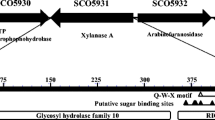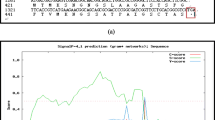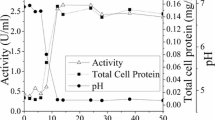Abstract
The gene encoding a thermostable β-d-xylosidase (GbtXyl43B) from Geobacillus thermoleovorans IT-08 was cloned in pET30a and expressed in Escherichia coli; additionally, characterization and kinetic analysis of GbtXyl43B were carried out. The gene product was purified to apparent homogeneity showing M r of 72 by sodium dodecyl sulfate polyacrylamide gel electrophoresis. The enzyme exhibited an optimum temperature and pH of 60 °C and 6.0, respectively. In terms of stability, GbtXyl43B was stable at 60 °C at pH 6.0 for 1 h as well as at pH 6–8 at 4 °C for 24 h. The enzyme had a catalytic efficiency (k cat/K M) of 0.0048 ± 0.0010 s−1 mM−1 on p-nitrophenyl-β-d-xylopyranoside substrate. Thin layer chromatography product analysis indicated that GbtXyl43B was exoglycosidase cleaving single xylose units from the nonreducing end of xylan. The activity of GbtXyl43B on insoluble xylan was eightfold higher than on soluble xylan. Bioinformatics analysis showed that GbtXyl43B belonging to glycoside hydrolase family 43 contained carbohydrate-binding module (CBM; residues 15 to 149 forming eight antiparallel β-strands) and catalytic module (residues 157 to 604 forming five-bladed β-propeller fold with predicted catalytic residues to be Asp287 and Glu476). CBM of GbtXyl43B dominated by the Phe residues which grip the carbohydrate is proposed as a novel CBM36 subfamily.






Similar content being viewed by others
References
Biely, P. (2003). Xylanolitic enzymes. In J. R. Whitacker, A. G. J. Voragen, & D. W. S. Wong (Eds.), Handbooks of food enzymology (pp. 879–915). New York: Dekker.
Saha, B. C. (2003). Hemicellulose bioconversion. Journal of Industrial Microbiology and Biotechnology, 30, 279–291.
Shallom, D., & Shoham, Y. (2003). Microbial hemicellulases. Current Opinion in Microbiology, 6, 219–228.
Polizeli, M. L. T. M., Rizzatti, A. C. S., Monti, R., Terenzi, H. F., Jorge, J. A., & Amorim, D. S. (2005). Xylanase from fungi properties and industrial applications. Journal of Applied Microbiology and Biotechnology, 67, 577–591.
Sunna, A., & Antranikian, G. (1997). Xylanolytic enzymes from fungi and bacteria. Critical Reviews in Biotechnology, 17, 39–67.
Teplitsky, A., Mechaly, A., Stojanoff, V., Sainz, G., Golan, G., Feinberg, H., et al. (2004). Structure determination of the extracellular xylanase from Geobacillus stearothermophilus by selenomethionyl MAD phasing. Acta Crystallographica, D60, 836–848.
Brüx, C., Ben-David, A., Shallom-Shezifi, D., Leon, M., Niefind, K., Shoham, G., et al. (2006). The structure of an inverting GH43 β-xylosidase from Geobacillus stearothermophilus with its substrate reveals the role of the three catalytic residues. Journal of Molecular Biology, 359, 97–109.
Hövel, K., Shallom, D., Niefind, K., Belakhov, V., Shoham, G., Baasov, T., et al. (2003). Crystal structure and snapshots along the reaction pathway of a family 51 α-l-arabinofuranosidase. EMBO Journal, 22, 4922–4932.
Golan, G., Shallom, D., Teplitsky, A., Zaide, G., Shulami, S., Baasov, T., et al. (2004). Crystal structures of Geobacillus stearothermophilus α-glucuronidase complexed with its substrate and products: mechanistic implications. Journal of Biological Chemistry, 279, 3014–3024.
Tan, I. (1999). Characterization of the thermophilic bacterium producing xylanolytic enzyme from hot spring Gunung Pancar Bogor (in Bahasa Indonesia), Master thesis, Institut Pertanian Bogor, Indonesia
Puspaningsih, N. N. T., Suwanto, A., Suhartono, M. T., Achmadi, S., Yogiara, S., & Kimura, T. (2008). Cloning, sequencing and characterization of the xylan degrading enzymes from Geobacillus thermoleovorans IT-08. Journal of Basic Science, 9, 177–187.
Nurizzo, D., Turkenburg, J. P., Charnock, S. J., Roberts, S. M., Dodson, E. J., McKie, V. A., et al. (2002). Cellvibriojaponicus α-l-arabinanase 43A has a novel five-blade β-propeller fold. Nature Structural Biology, 9, 665–668.
Sinnott, M. L. (1990). Catalytic mechanism of enzymic glycosyl transfer. Chemistry Review, 90, 1171–1202.
Qian, Y., Yamano, L. P., Preston, J. F., Aldrich, H. C., & Ingram, L. O. (2003). Cloning, characterization, and functional expression of the Klebsiella oxytoca xylodextrin utilization operon (xynTB) in E. coli. Applied and Environmental Microbiology, 69, 5957–5967.
Shallom, D., Leon, M., Bravman, T., Ben-David, A., Zaide, G., Belakhov, V., et al. (2005). Biochemical characterization and identification of the catalytic residues of a family 43 β-d-xylosidase from Geobacillus stearothermophilus T-6. Biochemistry, 44, 387–390.
Boraston, A., Bolam, D. N., Gilbert, H. J., & Davies, G. J. (2004). Carbohydrate-binding module: fine-tuning polysaccharide recognition. Biochemical Journal, 382, 769–781.
Altschul, S. F., Gish, W., Miller, W., Myers, E. W., & Lipman, D. J. (1990). Basic Local Alignment Search Tool. Journal of Molecular Biology, 215, 403–410.
Laemmli, U. K. (1970). Cleavage of structural proteins during the assembly of the head of bacteriophage T4. Nature, 227, 680–685.
Bradford, M. M. (1976). A rapid and sensitive method for the quantisation of microgram quantities of protein utilizing the principle of protein-dye binding. Analytical Biochemistry, 72, 248–254.
Miller, G. L. (1959). Use of dinitrosalicylic acid reagent for determination of reducing sugar. Analytical Chemistry, 31, 426–428.
Arnold, K., Bordoli, L., Kopp, J., & Schwede, T. (2006). The SWISS-MODEL workspace: a web-based environment for protein structure homology modeling. Bioinformatics, 22, 195–201.
Tamura, K., Peterson, D., Peterson, N., Stecher, G., Neiand, M., & Kumar, S. (2011). MEGA 5: molecular evolution genetics analysis using maximum likelihood evolutionary distance and maximum parsimony method. Molecular Biology and Evolution, 28, 2731–2739.
Jamal-Talabani, S., Boraston, A. B., Turkenburg, J. P., Tarbouriech, N., Ducros, V. M.-A., & Davies, G. J. (2004). Ab initio structure determination of CBM36: a new family of calcium-dependent carbohydrate binding modules. Structure, 12, 1177–1187.
Puspaningsih, N. N. T. (2004). Characterizing of xylanolytic enzymes, and cloning of genes encoding xylosidases from Geobacillus thermoleovorans IT-08 (in Bahasa Indonesia), Ph.D Thesis, Institut Pertanian Bogor. Indonesia
Higgins, F. C. (2001). ABC transporters: physiology, structure and mechanism—an overview. Research in Microbiology, 152, 205–210.
Shulami, S., Zaide, G., Zolotnitsky, G., Langut, Y., Feld, G., Sonenshein, A. L., et al. (2007). A two-component system regulates the expression of an ABC transporter for xylo-oligoccharides in Geobacillus stearothermophilus. Applied and Environmental Microbiology, 73, 874–884.
Low, K. O., Mahadi, N. M., Rahim, R. A., Rabu, A., Bakar, F. D. A., Murad, A. M. A., et al. (2011). An effective extracellular protein secretion by an ABC transporter system in Escherichia coli: statistical modeling and optimization of cyclodextrin glucanotransferase secretory production. Journal of Industrial Microbiology and Biotechnology, 38, 1587–1597.
Jordan, D. B., & Li, X. L. (2007). Variation in relative substrate specificity of bifunctional β-d-xylosidase/α-l-arabinofuranosidase by single mutations: role substrate distortion and recognition. Biochimica et Biophysica Acta, 1774, 1192–1198.
Wagshcal, K., Heng, C., Lee, C. C., Robertson, G. H., Orts, W. J., & Wong, D. W. S. (2009). Purification and characterization of a glycoside hydrolase family 43 β-xylosidase from Geobacillus thermoleovorans IT-08. Applied Biochemistry and Biotechnology, 155, 1–10.
Davis, G. J., Wilson, K. S., & Hendrissat, B. (1997). Nomenclature for sugar binding subsite in glycosyl hydrolase. Biochemical Journal, 321, 557–559.
Utt, E. A., Eddy, C. K., Keshav, K. F., & Ingram, L. O. (1991). Sequencing and expression of the Butyrivibrio fibrisolvens xylB gene encoding a novel bifunctional protein with β-d-xylosidase and α-l-arabinofuranosidase activities. Applied and Environmental Microbiology, 57, 1227–1234.
Sakka, K., Yoshikawa, K., Kojima, Y., Karita, S., Ohmiya, K., & Shimada, K. (1993). Nucleotide sequence of Clostridium stercorarium xylA gene encoding a bifunctional protein with β-d-xylosidase and α-l-arabinofuranosidase activities and properties of the translated product. Bioscience, Biotechnology, and Biochemistry, 57, 268–272.
Guillén, D., Sánchez, S., & Rodríguez-Sanoja, R. (2010). Carbohydrate-binding domains: multiplicityof biological roles. Applied Microbiology and Biotechnology, 85, 1241–1249.
Acknowledgments
This research was partially supported from the Directorate General of Higher Education, Ministry of Education and Culture, the Republic of Indonesia through Hibah Tim Pascasarjana Program to NNTP (2011–2012), Sandwich Course Program 2011 to AAID, as well as Hibah Doktor Program to AAID. We thank Mr. Kimiya Mizutani for his assistance in the preparation of enzyme purification, Mr. Didik Huswo Utomo for molecular art work as well as Mr. Tubagus Andhika Nugraha for critical reading of this manuscript.
Author information
Authors and Affiliations
Corresponding authors
Rights and permissions
About this article
Cite this article
Ratnadewi, A.A.I., Fanani, M., Kurniasih, S.D. et al. β-d-Xylosidase from Geobacillus thermoleovorans IT-08: Biochemical Characterization and Bioinformatics of the Enzyme. Appl Biochem Biotechnol 170, 1950–1964 (2013). https://doi.org/10.1007/s12010-013-0329-5
Received:
Accepted:
Published:
Issue Date:
DOI: https://doi.org/10.1007/s12010-013-0329-5




